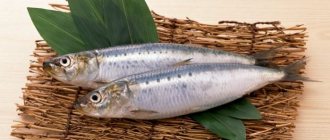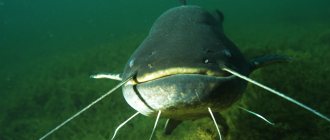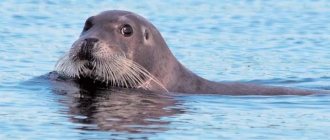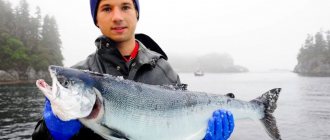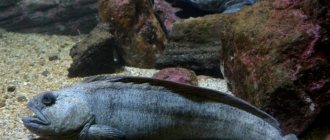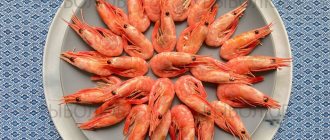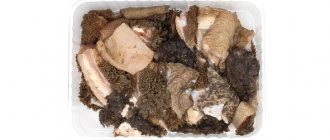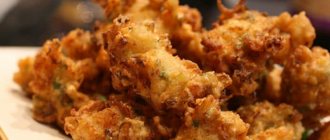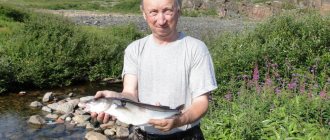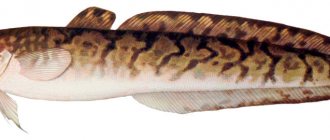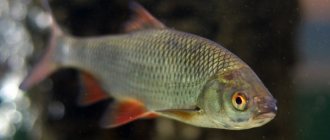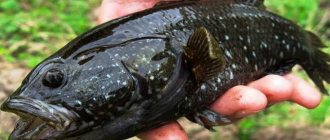The underwater world is fraught with many secrets and wonders; a striking example of this is the wide variety of freshwater and marine inhabitants of the depths.
Most people on the planet are familiar with a small number of representatives of aquatic fauna, and few people know what kind of fish is called a gurnard. Today in this article we will try to talk about this inhabitant of the sea, share basic information about this species, and also consider several interesting recipes for preparing dishes from this fish with photos. What is the most in your diet?
- Meat 42%, 151 votes
151 votes 42%151 votes - 42% of all votes
- Fruits and vegetables 24%, 86 votes
86 votes 24%
86 votes - 24% of all votes
- Dairy products and eggs 17%, 60 votes
60 votes 17%
60 votes - 17% of all votes
- Fish 17%, 59 votes
59 votes 17%
59 votes - 17% of all votes
Total votes: 356
18.04.2020
- Meat 42%, 151 votes
151 votes 42%151 votes - 42% of all votes
- Fruits and vegetables 24%, 86 votes
86 votes 24%
86 votes - 24% of all votes
- Dairy products and eggs 17%, 60 votes
60 votes 17%
60 votes - 17% of all votes
- Fish 17%, 59 votes
59 votes 17%
59 votes - 17% of all votes
Total votes: 356
18.04.2020
×
You or from your IP have already voted.
Description of sea rooster
The gurnard has a conical long body covered with scales with jagged edges. The head is well protected by a bone shell, on which there are small spines. At the tip of the snout there is a pair of protruding bony plates, on which there are 3-4 spines on each side. There are no transverse stripes on the body.
Trigla (sea cock) has 2 dorsal fins with different numbers of spines and rays. The back is covered by 27 small bone plates. The pectoral fins are very beautiful - they are purple on the outside and blue-green on the inside. They are quite big. Six movable processes extend from the fins, which serve as a kind of “legs” for the fish. The anal fin has almost 20 soft rays.
The gurnard, a fish whose photo can be seen in this article, can have several colors. In the Atlantic Ocean, trigla is usually gray in color, sometimes with a brown or reddish tint. Yellow-white spots are “scattered” throughout the body. There is a black spot on the first dorsal fin.
In the Mediterranean Sea, the guinea pig is red or has a brown tint. There is a dark spot on the dorsal fin. The fish in both reservoirs differ in length. In the Atlantic Ocean, trigla reaches an average of 50 centimeters (in rare cases, up to 90 cm), and in the Mediterranean Sea - up to 30.
Areola and habitat of the gurnard
The most common habitat of the gurnard is:
- Indian and Atlantic oceans.
- Northern, Azov, Marmara, Mediterranean, Black Sea and the western part of the Baltic.
- Strait of the English Channel.
Sea rooster is a bottom-dwelling sea fish. Prefers muddy or sandy bottom. It mainly lives at depths from 10 to 200 meters. In the warm season, triglu can be found near the banks or in river beds.
Population and status
The habitat of fish is not limited to one geographical location, therefore it is impossible to accurately calculate the population. What is known is that the number of beautiful marine inhabitants is declining. Fishing was partly to blame for this. Previously, trigla was considered a delicacy. Its flesh is very tender in taste. It was the unregulated catch that caused the disappearance of this beautiful species. But now a lot has changed.
Today, representatives of this species are listed in the Red Book. We hope that restrictive measures will help increase the number. Today it is forbidden to catch and kill sea roosters or cause any harm. If a fisherman gets hooked on such an individual, it should be carefully removed and released back into the sea. Of course, these restrictions do not always work fully. The number of triglas is decreasing not only due to fishing by fishermen. The activity of natural enemies poses no less danger, but it is simply impossible to protect the rooster from other fish. Due to their amazing appearance, these fish attract the attention of fishermen and aquarists. This plays against them, and the population decreases. A law came to the aid of the inhabitants, according to which everyone must protect this species. It is worth thinking about the future, to understand that we are destroying something with our own hands. what nature created and correct the situation.
What does trigla eat and how does it hunt?
The sea rooster's diet consists of shellfish, shrimp, small fish and crabs. But their favorite prey is red mullet. Trigla lies in wait for this fish, hiding in the algae bordering the open bottom. When a red mullet appears, the gurnard pushes off the bottom with its “legs” and overtakes its prey in one swift leap.
Trigla eats several times a day. But for adult fish, it is enough to eat once a week. Triggles hunt mainly at a depth of up to 30 meters. The processes in the form of “legs” serve not only for movement along the bottom. These are also external taste organs. When the trigla feels for prey in the bottom, it makes a lightning-fast throw. Due to their quick reaction, these fish are considered excellent hunters. Having had enough, the fish rests in the algae thickets, and in the evenings it floats to the surface to bask in the warm water.
Characteristics of the species
The photo shows what kind of fish the rooster is. This is a representative of the Ray-finned family. It can be found in the waters of the Black Sea. Some representatives of the genus are found in the Baltic Sea. Sometimes specimens were found in the Barents Sea, but they belonged to other species of ray-finned fish.
The body structure of an aquatic resident is unusual. She has six pairs of legs, which look like modified appendages that extend from her fins. Each limb looks like a ray. These paws help to move quickly along the seabed, looking for prey. In addition to movement, the function of these processes is the sense of smell and taste, this helps the rooster track down its food.
Pixabay.com
Such structural features of the body allow them to move quickly in deep waters, as well as jump out of the water and fly several meters in the air. You can often observe the amazing flight of these marine inhabitants in deep water. The rooster uses large gill fins for flight, which he maneuvers like wings.
The body is elongated, covered with scales. The head is dense, with bony or spinous plates in several rows present on top. That is why it is called trigla. The average body length is about half a meter, and body weight is about five kilograms. Adults become sexually mature at the age of three years. Spawning begins in summer. During the spawning period, each female has more than 200 thousand eggs.
This fish lives most of its time on the bottom. This is a place to rest and search for food. The diet of this small fish is based on small fish, plankton, and mollusks. They eat food infrequently. But in large portions. Adult specimens hunt approximately once every five to six days.
Features of the gurnard
In addition to flying over water, gurnards have the rare ability to “talk.” Triggles often make loud sounds that are clearly audible over water. These fish are capable of grunting, grumbling, purring and snoring. The sounds are so loud that during the Great Patriotic War they drowned out the noise of enemy boats, making it difficult to find out their exact location.
Can a guinea pig fly?
Sea roosters can fly over water up to 20 meters. Jumping forcefully out of the water, the trigla flies over the surface for almost 3 seconds. At this time, her fins spread out like wings. Then the fish plunges into the water with great noise, creating a fountain of splashes. Flight speed can reach 40 km/h. Sea roosters fly mainly after a storm, in the evenings, far from the coast. It is at this time that a lot of small fish gather on the surface of the water, which the trigla hunts for.
Sea rooster breeding
Sea roosters begin spawning in June and continue until the end of August. Depending on the habitat, this period can be from January to September. For spawning, fish choose reservoirs with a sandy bottom. Females are able to spawn four times throughout the summer. An individual weighing 2 kilograms lays almost 14 thousand eggs. Then maturation begins, and after 7 days the fry appear. At the age of two weeks, young triggles look very similar to adult fish.
Despite the large number of eggs that females lay, there are fewer and fewer guinea pigs. The main factors influencing the population decline are the deterioration of the ecological situation and the activity of fishermen. Sea cockerels are quite tasty, and many gourmets are willing to pay big money for trigla delicacies. Demand stimulates supply - in some places poachers organize a targeted hunt for this fish.
Social structure and reproduction
Photo: Black Sea rooster fish
The fish have a rather peculiar disposition; they have a hard time making contact with other inhabitants of the reservoir, so they prefer not to contact representatives of other species. Instead, roosters lead largely solitary lives, rarely associating with members of their own species.
Cockerels in nature begin to reproduce at about 5-6 months, when they become sexually mature. If we talk about breeding at home, then special conditions will need to be created for spawning, since the fish are very picky in this matter.
To reproduce, fish need the following conditions:
- warm water;
- a secluded place to create a nest;
- twilight.
The fish carefully choose a place for spawning, preferring waters with a temperature of about 30 degrees with poor lighting. Thickets of underwater plants and burrows are ideal for equipping a kind of nest. First, the male begins to build a kind of nest: air bubbles connected by his saliva.
After this, he begins to approach the female, gradually “hugging” her and squeezing out several eggs, which he carries to the nest and returns for the next ones. When the job is done, the female swims away, but the male remains to guard his nest. By the way, he will take care of the babies for some time after birth.
Interesting fact: The male is such a caring father that he can drive the female away from the nest so zealously that he can even kill her.
After about 1.5 days, the fry will hatch, and after another day the protective bubble will finally burst and they will be able to start living on their own. But with marine species things are a little different. They become fully sexually mature around 4 years of age. Until this time, although they do not live with their parents, they do not take part in spawning and life activities in general as much as adults.
At one time, an adult female lays approximately 300 thousand small eggs. The diameter of each is approximately 1.3-1.6 mm (including the fat drop). Sea roosters go to spawn in the summer. The eggs ripen on average for about 1 week, after which fry hatch from them.
Interesting fact: Even when they are very small, guinea fry are completely similar in appearance to adults.
How to cook sea rooster?
Sea rooster meat is white, dense, contains almost no bones and is similar to steamed chicken. In French cuisine, this fish is a mandatory ingredient for Marseille bouillabaisse soup. Sea rooster meat can be added to a variety of salads. It goes well with cheese, herbs and vegetables.
You can bake a sea rooster in several ways: in parchment, with apples and spinach. Or you can simply fry the fish with mushrooms and onions. Trigla is served to the table as a hot dish. Sea rooster meat can be baked in pots with potatoes, mozzarella and tomatoes, or filleted with a cheese crust. Trigla cooked whole is very tasty. Before baking, it is rubbed with garlic, pepper, salt and olive oil.
Sea rooster: stuffed fish recipe
For this dish you will need 300 grams of trigla, a small head of garlic, a glass of mayonnaise, 100 grams of vegetable oil, pepper and salt. First, several cuts are made across the back of the fish, into which garlic is inserted into slices. Then the sea rooster needs to be rubbed with salt and pepper. Vegetable oil is poured onto a baking sheet. The fish must be sprinkled with flour on one side only - and placed on a baking sheet. Then pour in mayonnaise and cook in the oven over medium heat for half an hour.
Fish is in great demand among Italian and French gourmets. In these countries, there are even several traditional dishes that include gurnard. The fish is really very tasty. We recommend that all tourists visiting Italy and France try it. You can taste the gurnard in every restaurant specializing in seafood cuisine.
Composition and beneficial properties
Cooked fish does not contain harmful properties. It is not recommended for those who have individual intolerances or food allergies.
List of useful properties:
- high content of easily digestible protein and low percentage of fat. This makes the dishes dietary;
- fish contains many minerals and vitamins A and E;
- contains potassium. It normalizes heart function and reduces the risk of cardiovascular diseases;
- Suitable for preparing children's dishes. There are no small bones in the fillet;
- The high content of Omega-3 fatty acids helps normalize metabolism in the human body.
